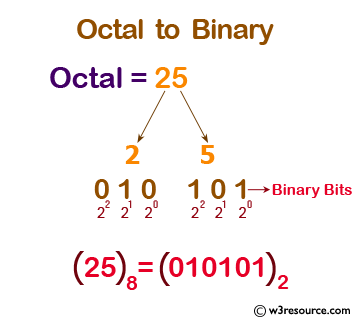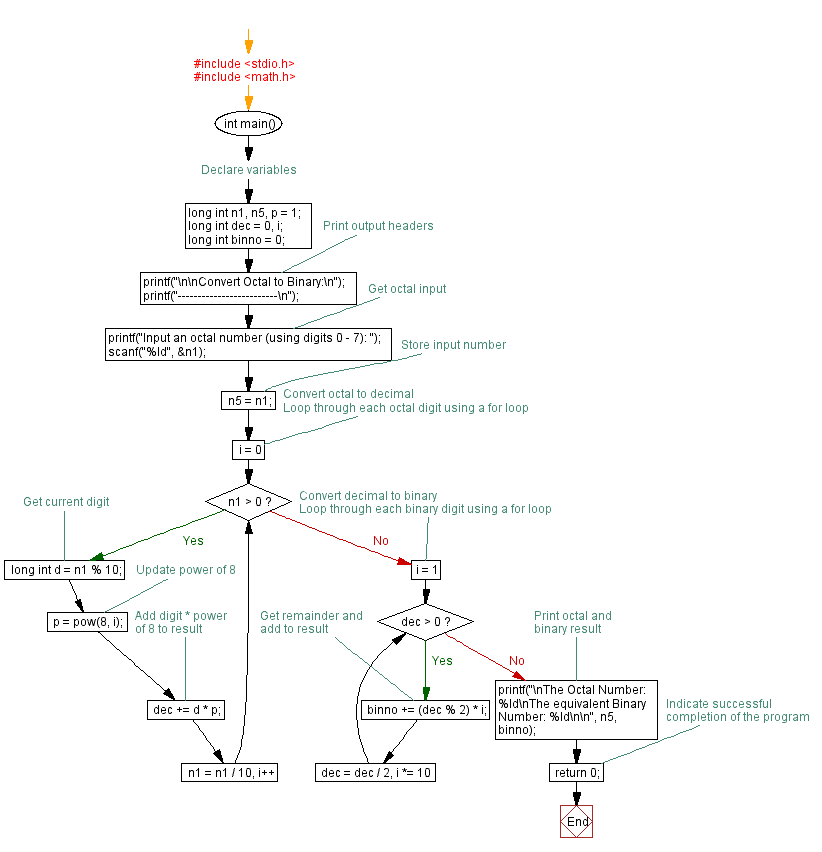C Exercises: Convert an octal number into binary
54. Octal to Binary Conversion
Write a program in C to convert an octal number into binary.
This C program converts an octal number into its equivalent binary representation. It prompts the user to input an octal number, then iterates through each digit to calculate its decimal equivalent using a for loop. Afterward, it converts the decimal number obtained to binary format, storing and printing both the original octal number and its binary equivalent.
Visual Presentation:

Sample Solution:
C Code:
#include
#include
int main() {
// Declare variables
long int n1, n5, p = 1;
long int dec = 0, i;
long int binno = 0;
// Print output headers
printf("\n\nConvert Octal to Binary:\n");
printf("-------------------------\n");
// Get octal input
printf("Input an octal number (using digits 0 - 7): ");
scanf("%ld", &n1);
// Store input number
n5 = n1;
// Convert octal to decimal
// Loop through each octal digit using a for loop
for (i = 0; n1 > 0; n1 = n1 / 10, i++) {
// Get current digit
long int d = n1 % 10;
// Update power of 8
p = pow(8, i);
// Add digit * power of 8 to result
dec += d * p;
}
// Convert decimal to binary
// Loop through each binary digit using a for loop
for (i = 1; dec > 0; dec = dec / 2, i *= 10) {
// Get remainder and add to result
binno += (dec % 2) * i;
}
// Print octal and binary result
printf("\nThe Octal Number: %ld\nThe equivalent Binary Number: %ld\n\n", n5, binno);
return 0; // Indicate successful completion of the program
}
Output:
Convert Octal to Binary:
-------------------------
Input an octal number (using digit 0 - 7) :57
The Octal Number : 57
The equivalent Binary Number : 101111
Explanation:
Here's a brief explanation of the above code:
- Header and Declaration:
- Includes the necessary header files ('stdio.h' for input/output and "math.h" for mathematical functions).
- Declared variables: 'n1' (input octal number), 'n5' (backup of the input), 'p' (power of 8 multiplier), 'dec' (resulting decimal number), i (loop variable for octal to decimal conversion), 'binno' (resulting binary number).
- User Input:
- Asks the user to input an octal number (using digits 0 - 7).
- Reads the input and stores it in the variable 'n1'.
- Octal to Decimal Conversion (using a for loop):
- Initializes i to 0 for the power of 8.
- Iterates through each digit of the octal number using a "for" loop.
- Calculates the contribution of each digit to the decimal number using the "pow()" function.
- Accumulates the result in the variable 'dec'.
- Decimal to Binary Conversion (using a while loop):
- Resets i to 1 for the power of 2.
- Repeatedly divides the decimal number ('dec') by 2 using a "while" loop.
- Calculates the remainder and adds it to the binary result ('binno').
- Updates to the power of 2.
- Continue until the decimal number becomes 0.
- Result Display:
- Prints the input octal number and its equivalent binary number.
- Return Statement:
- Returns 0 to indicate successful program completion.
Flowchart:

For more Practice: Solve these Related Problems:
- Write a C program to convert an octal number to binary by processing each digit into its 3-bit binary equivalent.
- Write a C program to convert an octal number to binary without using arrays by employing arithmetic operations.
- Write a C program to convert an octal number to binary and count the number of 1’s in the resulting binary number.
- Write a C program to convert an octal number to binary and display the output in groups of four digits.
Go to:
PREV : Binary to Octal Conversion.
NEXT : Decimal to Hexadecimal Conversion.
C Programming Code Editor:
Have another way to solve this solution? Contribute your code (and comments) through Disqus.
What is the difficulty level of this exercise?
Test your Programming skills with w3resource's quiz.
